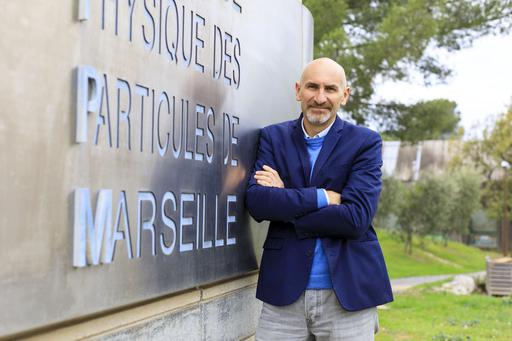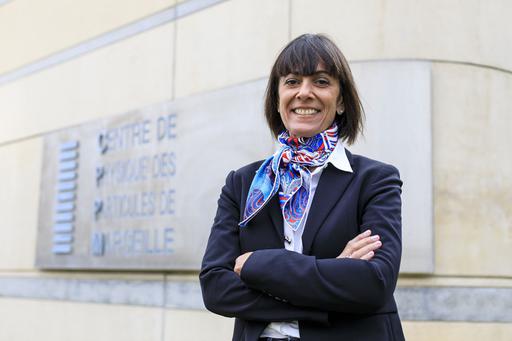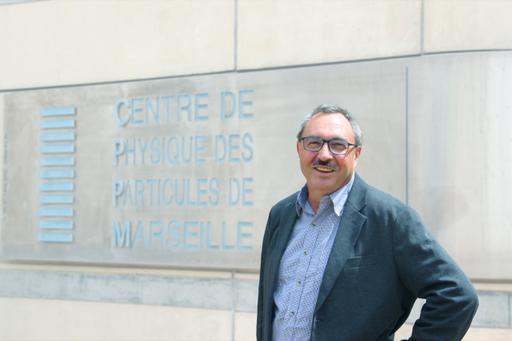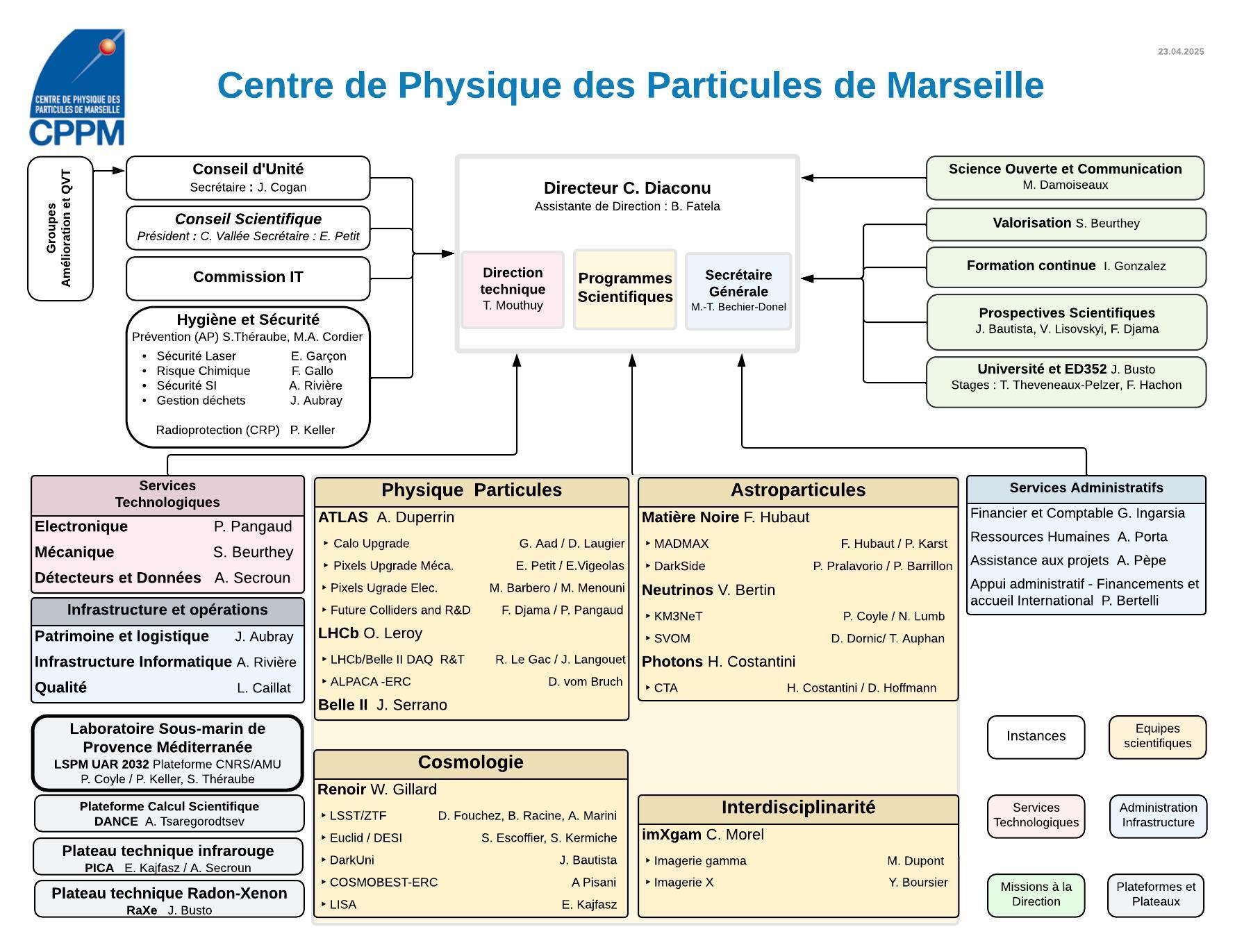Presentation
The laboratory
CPPM, the Marseille Particle Physics Centre is a Joint Research Unit (UMR 7346). The laboratory is part of the Institut national de physique nucléaire et de physique des particules (IN2P3), under the joint supervision of the French National Centre for Scientific Research (CNRS) and Aix-Marseille University.
The research conducted at CPPM is at the crossroads of two infinites; ranging from the study of the elementary components of matter - the infinitely small - to the exploration of the cosmos - the infinitely large. To follow these we design and build state-of-the-art detector systems, often required to operate under extreme conditions: deep under the sea, in space or underground. Most of our research is carried out within leading international scientific collaborations and our contributions are recognized worldwide. We participate in the training of young people for research careers, directly through our research programs and also through their university education. Our laboratory is also very active in promoting technological developments resulting from its research.
All the CPPM activities are based on values of ethics, deontology and integrity, with a focus on science and society. CPPM is committed to conducting research within the framework of open science, promoting diversity and inclusion in the workplace, and preserving the environment.
In figures
-
60 foreign visitors and trainees per year
-
20 laboratories with which we collaborate through academic agreements, i.e. more than 15 different countries
-
15 symposia each year, attracting around 500 researchers
-
1983 year of creation of the CPPM
-
4500 the number of square metres of our building, located in the heart of the Calanques of Luminy Natural Park
Our research axes
We seek to understand the Universe and its composition through laboratory experiments and observations of often violent celestial phenomena. Our research is aligned along three main axes:
- Particle physics: of the infinitely small, to identify the most basic constituents of matter, measure their properties and understand their interactions
- Astroparticle physics: the infinitely large seen through the infinitely small: studying the most violent phenomena in the Universe to look for the origins of very high energy cosmic rays and radiation
- Observational cosmology: direct studies of the infinitely large to determine and understand the history of the Universe, its origins, evolution and the nature of its constituents
In addition to these three main axes of fundamental research leading to frontiers of scientific and associated technology, we are strongly committed to interdisciplinary themes and their societal applications, such as biomedical imaging, modern intensive computing and studies of the deep-sea environment.
Dedicated instrumentation
We contribute to several very large multinational infrastructures essential to today's research. We are committed to many international collaborations: some having more than 3,000 collaborators. Examples include large experiments (ATLAS and LHCb) operating at the CERN LHC (Large Hadron Collider) in Geneva, the French "Grille" national computing infrastructure, and the CTA and LSST terrestrial telescopes. In addition CPPM is a major participant in the ANTARES and KM3NeT deep sea neutrino telescope collaborations, serving as the host laboratory for the ANTARES infrastructure and the KM3NeT western site, both located at a depth of around 2400m near Toulon. We are also involved in the construction of major elements of the Euclid space telescope satellite, which is partly supported by CNES and ESA (the French and European space agencies).
From a technological point of view, these contributions require cutting edge know-how developed by CPPM experts in the fields of electronics, mechanics, computer science and instrumentation. Our highly qualified staff design and build innovative tools and are nationally and internationally recognized for their technological accomplishments. The laboratory benefits from a state-of-the-art infrastructure: including experimental areas located within clean rooms as well as a modern, well-equipped mechanical workshop and a large assembly hall with overhead crane facilities.
Our relations with society & dissemination of knowledge
We are committed to sharing knowledge, participating in teaching activities and the dissemination of scientific culture to highlight French research. In addition we continue to build close links with regional industrial competitiveness clusters. In this way technological developments made at CPPM in the context of fundamental research are aimed wherever possible - following evolution of the technology from the fundamental to the application - to be transferred into the social and economic world. In the context of its social responsibility, the CPPM is involved in a transition process to combine its research activities with climate and environmental action. A number of steps are being taken in this direction.
Our latest activity reports
You can find 2024 activity report here 2024 activity report
You can find 2023 activity report here 2023 activity report
You can find 2022 activity report here 2022 activity report
You can find 2021 activity report here 2021 activity report
You can find 2020 activity report here 2020 activity report
You can find 2019 activity report here 2019 activity report
Direction
- Cristinel Diaconu, director
- Bérénice Fatela, director assistant
- Marie-Thérèse Bechier-Donel, secretary-general
- Thierry Mouthuy, technical director
Bodies
Council of Unit (2024-2028)
President: C. Diaconu
Secretary: V. Roux
Elected members: O. Angelini, J. Cogan, C. Dupré-Rachédi, D. Laugier, J-P. Logier, Ch. Morel, A. Pisani, I. Richer, J. Serrano, T. Weicherding
Nominated members: P. Breugnon, J. Busto, M. Damoiseaux, D. Hoffmann, T. Theveneaux-Pelzer, D. Vom Bruch
Elected PhD: M-S. Carrasco
Invited members: M.-T. Donel (Administrative Director), Th. Mouthuy (Technical Director), S. Théraube (Prevention Assistant)
Scientific Council (2021-2024)
President: C. Vallée
Secretary: E. Petit
Laboratory Director: C. Diaconu
Elected members: P. Barrillon, D. Dornic, S. Escoffier, E. Petit, A. Poluektov
Nominated members: R. Le Gac, C. Vallée
External members: Nelson Christensen (OCA), Caroline Collard (IPHC), Christophe Grojean (Desy), Gaia Lanfranchi (Frascati/INFN), Veronique Puill (IJCLAB), Mathieu Tristram (IJCLab)
Invited members: S. Beurthey (Mechanics Department), M.-T. Donel (Administrative Director), P. Pangaud (Electronics Department), A.Secroun (Computing and Instrumentation department), Th. Mouthuy (Technical Director)
Engineers and Technicians Committee (2024-2028)
President: C. Diaconu
Elected members : D. Fougeron, E. Garçon, A. Porta, A. Rivière, E. Vigeolas
Nominated members: P. Barrillon, E. Le Guirriec, J. Laurence
Ex-officio members: S. Beurthey, M.-T. Donel, Th. Mouthuy, P. Pangaud, A. Secroun
Health and Safety Committee (2024-2028)
President: C. Diaconu
Elected members: Ph. Lagier, D. Laugier, J. Laurence, A. Porta, A. Rivière
Ex-officio members: M.-T. Donel, S. Théraube, P. Keller, Th. Mouthuy
Expert invited members: J. Aubray (Wealth and Logistics Department), E. Garçon (Laser Safety Referee), F. Gallo (Chemical Risk Manager), F.Gensolen (first-aid equipment management), A. Rivière (Information Systems Security Officer), J. Aubray (Waste Management Officer) and other expert members for specific risks, as defined in § 2.1.4 of the Internal Rules
Representatives of the governing bodies: Prevention and Safety Engineer, Prevention Doctors, IN2P3 Radiation Protection Inspector
Responsability & contacts
| Responsabilities | Names |
|---|---|
| Communication manager | Magali Damoiseaux |
| Quality responsible | Laurence Caillat |
| ATLAS team responsible | Arnaud Duperrin |
| Belle II team responsible | Justine Serrano |
| Dark Matter team responsible | Fabrice Hubaut |
| LHCb team responsible | Olivier Leroy |
| Renoir team responsible | William Gillard |
| Astroparticules Neutrinos team responsible | Vincent Bertin |
| Astroparticules Photons team responsible | Heide Costantini |
| imXgam team responsible | Christian Morel |
| Responsible of electronic department | Patrick Pangaud |
| Responsible of Détectors and Data department | Aurélia Secroun |
| Responsible of mechanic department | Stéphan Beurthey |
| Responsible of department "Patrimoine Logistique" | Jérôme Aubray |
| Responsible of Computing Insfrastrucure | Adrien Rivière |
| Contacts | Names |
| Valorization | Stéphan Beurthey |
| Training | Isabelle Richer |
| in connection with the university | José Busto |
| Equality referent in the laboratory | Elisabeth Petit |
| Sustainable Development | Yann Coadou |
| Internships | Timothée Theveneaux-Pelzer@cppm.in2p3.fr (Physics) and Frédéric Hachon (Technical) |
| Secondary School | Fabrice Feinstein and Julien Zoubian (Colleges), Marlon Barbero et Julien Cogan (High Schools) |
| Administrative Internships | Bérénice Fatela |
| TIPE | Heide Costantini |
| Apprentices | Dirk Hoffmann |
| Seminars | Vitalii Lisovskyi, Farès Djama and Gaya Benane |
| Prevention | Stéphane Théraube and Marie-Ange Cordier |
| Radioprotection advisor | Pascale Keller |
| Laser security | Evelyne Garçcon |
| Chemical risk | Fabrice Gallo |
| IT security | Adrien Rivière |
| Waste management | Jérôme Aubray |
Link to the CPPM directory.
Fundings
| Partner | Scientific programmes/teams | Projects |
|---|---|---|
| ANR | Astroparticles/Neutrinos | PRCI LACTEL |
| ANR | Astroparticles/Dark Matter | PRC FIDAR |
| ANR | Astroparticles/Neutrinos | PRC IRENE |
| ANR | Particle Physics/ATLAS | PRC APICS |
| ANR | Particle Physics/ATLAS | ESDIR DIVE |
| ANR | Cosmology/Renoir - Euclid | PRME DISPERS |
| ANR | Astroparticles/Neutrinos | JCJC ENTER |
| ANR | Cosmology/Renoir - LSST | PRC ZTF |
| ANR | Cosmology/Renoir - LSST | PRC DeepDip |
| ANR | Interdisciplinarity/imXgam | PRC ClearMind |
| ANR | Particle Physics/ATLAS | PRC AIDAQ |
| ANDRA, DAMAVAN IMAGING, WEEROC | interdisciplinarity/imXgam | TEMPORAL II |
| CNES | Astroparticles/Neutrinos | Phase E2 of the SVOM scientific ground segment (FSGS) |
| CNES | Cosmology/Renoir - Euclid | Euclid E2, Euclid Missions Sciences, Euclid SGS |
| CNES | Cosmology/Renoir - Euclid | 3 co-financed thesis grants |
| CE | Particle Physics/Belle II | H2020 ERC NEPAL |
| CE | Particle Physics/LHCb | H2020 ERC ALPaCA |
| CE | Cosmology/Renoir - Euclid | H2020 ERC COSMOBEST |
| CE | Particle Physics/ATLAS | H2020 AIDA-INNOVA |
| CE | Astroparticles/Neutrinos | H2020 EOSC FUTURE |
| CE | Astroparticles/Neutrinos | H2020 KM3NeT INFRADEV-2 |
| DETECTION TECHNOLOGY | interdisciplinarity/imXgam | Collaboration contract CIFRE grant |
| Inserm | Interdisciplinarity/imXgam | TIARA |
| Assocation of Universities for Research in Astronomy (AURA) | Astroparticle/Neutrinos | Scientific collaboration contract |
| CPER 2021-2027 : STATE/South Region, DRARI PACA, CNRS | Astroparticle/Neutrinos | NEUMED |
| A*MIDEX University Foundation - Chair of excellence | Cosmology/Renoir - LSST | DARKUNI |
| A*MIDEX University Foundation - Chair of excellence | Cosmology/Renoir - Euclid | COSMO-SP-VOIDS |
| A*MIDEX University Foundation - "White Research" Call for Proposals | Cosmology/Renoir - LSST | XLCOSMO |
| A*MIDEX University Foundation - Interdisciplinary Call for Proposals | Astroparticles/Neutrinos | NEXCOS |
One CPPM PhD student is preparing his thesis with co-financing from the South Region.



